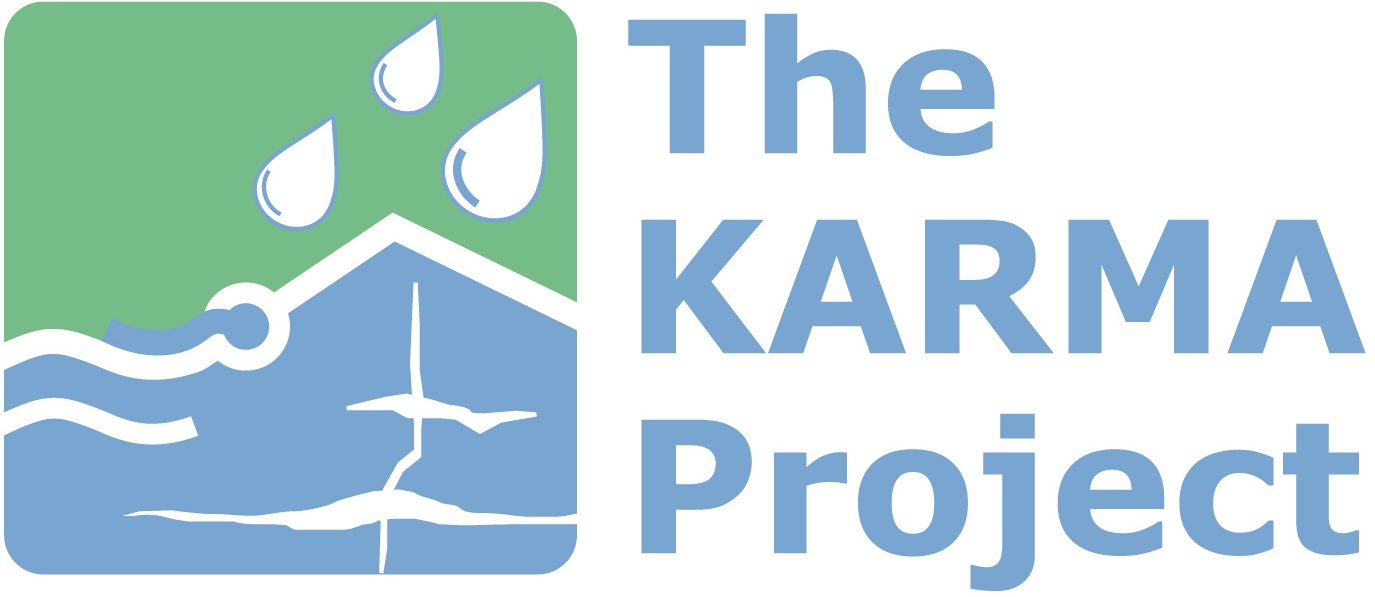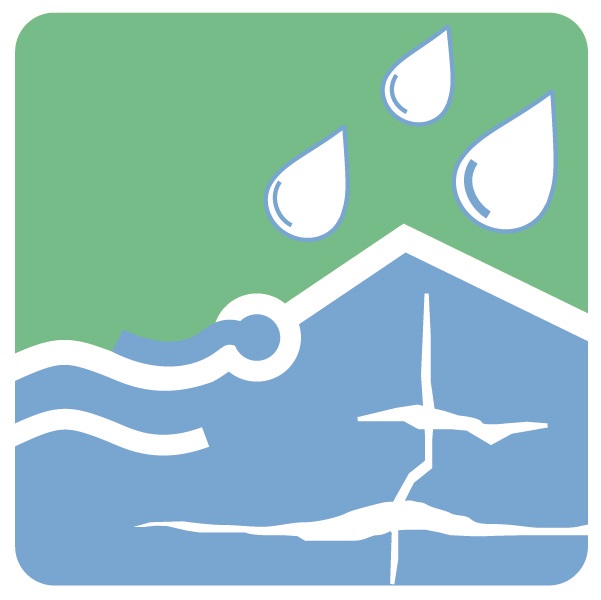Besides the application of established methods in karst hydrogeology, KARMA contributes to the development of novel experimental and modeling methods.
At the scale of individual springs, KARMA uses different monitoring, sampling and analytical methods for discharge, physical, chemical and microbial water quality, with a focus on continuous or high-temporal resolution monitoring, in order to account for the high temporal variability of karst systems:
- Spring discharge (Q) is measured using tracer-dilution (for turbulent conditions) or velocityfield measurements (for laminar conditions) in order to establish stage-discharge curves; pressure probes connected to data loggers are typically used for continuous monitoring.
- Temperature (T), specific electrical conductivity (SEC) and turbidity is measured continuously using adequate multi-parameter probes and data loggers.
- Total organic carbon (TOC) is measured using conventional techniques and novel, fluorescence-based monitoring methods (Frank et al. 2018; Quiers et al. 2014).
- Water chemistry (major and trace elements) is measured in samples at event-based and seasonal timescales (Bicalho et al. 2012) and analyzed using ICP-MS for all metals (usually cations), titration for bicarbonate and IC for other anions.
- Nitrate is analyzed in samples using IC or by means of novel on-line measurement devices (Huebsch et al. 2015).
- Microbial water quality is measured using conventional cultivation methods (e.g. MPN, Colilert) and novel online-monitoring techniques, such as β-D-glucuronidase activity using the mobile ColiMinder device (Ender et al. 2017), or flow cytometry.
- Particle-size distribution (PSD) is often closely related to spring water quality and is monitored at high temporal resolution using mobile particle counters (Pronk et al. 2007), which are continuously improved in close cooperation with the producer.
- At selected springs, additional parameters are measured, such as rare earth elements (REE) and other dissolved trace metals, as well as radon (222Rn) and CO2.
Statistical analyses, in particular time-series analyses, but also artificial neural networks (ANR) are used to identify relations between relevant contaminants (e.g. fecal bacteria) and parameters that can be measured continuously, such as discharge, turbidity and TOC (Massei et al. 2006). On this basis, it is possible to establish early-warning systems for spring water contamination that can help decision makers to take appropriate actions using telemetry and real-time data assessment.
At the scale of catchments / karst aquifers (Figure 2, Table 1-3b), KARMA applies various experimental and numerical methods in order to quantify groundwater recharge from precipitation and floodwater, assess groundwater vulnerability to contamination and establish prediction tools for extreme events:
- Groundwater vulnerability mapping using the COP method and other methods based on the “European Approach” to vulnerability mapping, validated by artificial tracer tests and water-quality variability observed at karst springs (Andreo et al. 2006).
- Measurements of meteorological parameters at weather stations (additional to the existing station network) and soil moisture measurements to obtain input parameters for aquifer recharge (cooperation with the DFG Emmy Noether project “GloW” of Andreas Hartmann).
- Recharge mapping using an improved version of APLIS (Andreo et al., 2008), supported by recharge modeling using Hydrus 1D and 2D/3D, and validated by dynamic water balances and stable isotope methods using 2H and 18O (Amoruso et al., 2013; Tallini et al., 2014).
- Further development of artificial neural networks (see above) and lumped-parameter models for simulating the overall system behaviour (Guinot et al. 2015; Tritz et al. 2011) and for improved predictions concerning impacts of extreme events, such as floods and droughts (Jourde et al. 2014, 2007), based on the KarstMod platform (Mazzilli et al. 2018).
- Advancement of spatially-distributed models specifically adapted for karst aquifers as tools for improved water management (Doummar et al. 2012; Xanke et al. 2016), including a new generic model which captures the multi-scale channel network, hierarchical permeability and evolution over time based on recently developed models (Wang et al. 2017a,b; Fischer et al. 2017).
- Mapping and approximate evaluation of karst groundwater-dependent ecosystems (KGDE), by means of field work and information available at environmental agencies (Bertrand et al. 2012).
At the scale of the entire Mediterranean area, KARMA applies various methods of data collection and evaluation, cartographic methods and GIS techniques:
- Collection and evaluation of data concerning important karst springs and other water abstraction structures, building on our existing WOKAM database and network of regional experts.
- Compilation and evaluation of existing geological and hydrogeological maps in order to refine the existing World Karst Aquifer Map (Figure 1) for the Mediterranean area.
- Generalization and completion of MEDKAM at a printing scale of 1:5 Million.
- Regionalization of groundwater recharge for the entire Mediterranean area, using the APLIS method, existing hydro-climatic information, geostatistical methods, and satellite data, e.g. from the NASA Global Precipitation Measurement network (Longenecker et al. 2017).
- Groundwater vulnerability mapping, using the European Approach (and derived methods) as a conceptual basis, although substantial generalizations will be indispensable (Daly et al. 2002).
- Preparation of advanced maps showing the floodwater storage potential and water stress.
Printing and dissemination of the maps will be done in cooperation with the WHYMAP team (UNESCO and BGR). The digital version will be published on the BGR website, to ensure permanent access and updating, as it is done for other WHYMAP products. UNESCO has presented the prospect of financial support for the printing and dissemination of the maps.
Literature
Goldscheider, N., Drew, D., 2007. Methods in karst hydrogeology. Taylor & Francis, London.
Frank, S., Goeppert, N., Goldscheider, N., 2018. Fluorescence-based multi-parameter approach to characterize dynamics of organic carbon, faecal bacteria and particles at alpine karst springs. Science of the Total Environment 615, 1446-1459.
Huebsch, M., Grimmeisen, F., Zemann, M., Fenton, O., Richards, K.G., Jordan, P., Sawarieh, A., Blum, P., Goldscheider, N., 2015. Technical Note: Field experiences using UV/VIS sensors for high-resolution monitoring of nitrate in groundwater. Hydrology and Earth System Sciences 19, 1589-1598.
Ender, A., Goeppert, N., Grimmeisen, F., Goldscheider, N., 2017. Evaluation of beta-D-glucuronidase and particle-size distribution for microbiological water quality monitoring in Northern Vietnam. Science of the Total Environment 580, 996-1006.
Massei, N., Dupont, J.P., Mahler, B.J., Laignel, B., Fournier, M., Valdes, D., Ogier, S., 2006. Investigating transport properties and turbidity dynamics of a karst aquifer using correlation, spectral, and wavelet analyses. Journal of Hydrology 329, 244-257.
Andreo, B., Goldscheider, N., Vadillo, I., Vias, J.M., Neukum, C., Sinreich, M., Jimenez, P., Brechenmacher, J., Carrasco, F., Hotzl, H., Perles, M.J., Zwahlen, F., 2006. Karst groundwater protection: First application of a Pan-European Approach to vulnerability, hazard and risk mapping in the Sierra de Libar (Southern Spain). Science of the Total Environment 357, 54-73.
Andreo, B., Vias, J., Duran, J.J., Jimenez, P., Lopez-Geta, J.A., Carrasco, F., 2008. Methodology for groundwater recharge assessment in carbonate aquifers: application to pilot sites in southern Spain. Hydrogeology Journal 16, 911-925.
Amoruso, A., Crescentini, L., Petitta, M., Tallini, M., 2013. Parsimonious recharge/discharge modeling in carbonate fractured aquifers: The groundwater flow in the Gran Sasso aquifer (Central Italy). Journal of Hydrology 476, 136-146.
Tallini, M., Falcone, R.A., Carucci, V., Falgiani, A., Parisse, B., Petitta, M., 2014. Isotope hydrology and geochemical modeling: new insights into the recharge processes and water-rock interactions of a fissured carbonate aquifer (Gran Sasso, central Italy). Environmental Earth Sciences 72, 4957-4971.
Tritz S., Guinot V., Jourde H., 2011. Modeling the behaviour of a karst system catchment using non-linear hysteretic conceptual model, Journal of Hydrology, 397 : 250-262.
Guinot, V., Savean, M., Jourde, H., Neppel, L., 2015. Conceptual rainfall-runoff model with a two-parameter, infinite characteristic time transfer function. Hydrological Processes 29, 4756-4778.
Jourde H., Lafare A., Mazzilli N., Belaud G., Neppel L., Doerfliger N., Cernesson F. (2014) Flash flood mitigation as a positive consequence of anthropogenic forcings on the groundwater resource in a karst catchment, Environmental Earth Sciences, 71, 573–583.
Xanke, J., Jourde, H., Liesch, T., Goldscheider, N., 2016. Numerical long-term assessment of managed aquifer recharge from a reservoir into a karst aquifer in Jordan. Journal of Hydrology 540, 603-614.
Doummar, J., Sauter, M., Geyer, T., 2012. Simulation of flow processes in a large scale karst system with an integrated catchment model (Mike She) - Identification of relevant parameters influencing spring discharge. Journal of Hydrology 426, 112-123.
Bertrand, G., Goldscheider, N., Gobat, J.M., Hunkeler, D., 2012. Review: From multi-scale conceptualization to a classification system for inland groundwater-dependent ecosystems. Hydrogeology Journal 20, 5-25.
Fischer, P., Jardani, A., Wang, X., Jourde, H., Leeog, N., 2017. Identifying Flow Networks in a Karstified Aquifer by Application of the Cellular Automata-Based Deterministic Inversion Method (Lez Aquifer, France). Water Resources Research 53, 10508-10522.
Wang, X., Q. Lei, L. Lonergan, H. Jourde, O. Gosselin, J. Cosgrove, 2017. Heterogeneous fluid flow in fractured layered carbonates and its implication for generation of incipient karst, Advances in Water Resources
Daly, D., Dassargues, A., Drew, D., Dunne, S., Goldscheider, N., Neale, S., Popescu, I.C., Zwahlen, F., 2002. Main concepts of the "European approach" to karst-groundwater-vulnerability assessment and mapping. Hydrogeology Journal 10, 340-345.
Doummar, J., Sauter, M., Geyer, T., 2012. Simulation of flow processes in a large scale karst system with an integrated catchment model (Mike She) - Identification of relevant parameters influencing spring discharge. Journal of Hydrology 426, 112-123.


